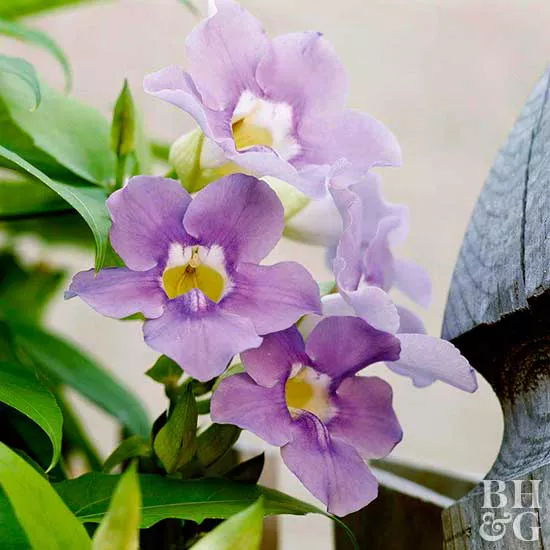Sky vine is a tropical vine with lush, big, ruffled purple or lavender-blue flowers all summer long. The color harmonizes with just about everything, and the leaves create a nice backdrop for the bloom. It scrambles up trellises and trails out of pots during the heat of summer. In tropical environments, sky vine is an evergreen woody perennial blooming from early summer until late winter. In cool climates, it is grown as an annual, only climbing about 12 feet and blooming for several weeks from midsummer until early fall.
Sky Vine Overview
| Genus Name | Thunbergia grandiflora |
| Common Name | Sky Vine |
| Additional Common Names | Blue Trumpet Vine, Sky Flower |
| Plant Type | Annual, Perennial, Vine |
| Light | Sun |
| Height | 10 to 20 feet |
| Width | 2 to 3 feet |
| Flower Color | Purple |
| Season Features | Fall Bloom, Summer Bloom |
| Special Features | Good for Containers, Low Maintenance |
| Zones | 10, 11 |
| Propagation | Seed |
Where to Plant Sky Vine
Plant sky vine in full sun or if you are located in Zone 10 or 11 in a location that receives shade in the afternoon. The vine needs well-draining soil and prefers a neutral pH.
Sky vine needs vertical space. It will quickly scramble up a trellis, pergola, or fence. In temperate regions where it grows as an annual, it typically climbs 10 to 12 feet. In tropical regions, expect it to climb 20 feet or more and produce woody stems. You can also plant sky vine in a hanging basket or atop a wall to create a curtain of color.
In a frost-free, tropical climate, sky vine is potentially invasive. It has been identified as an invasive species in Hawaii and as a high-invasion risk in parts of Florida.
How and When to Plant Sky Vine
Nursery-grown plants are not widely available, but you can start sky vine from seed.
To get a head start on the growing season, start the seeds indoors 6 to 8 weeks before the last spring frost. Fill pots with soilless potting mix and plant 2 to 3 seeds in each pot, ¼ inch deep. Germination at 75 degrees F takes 14 to 21 days. After seedlings emerge and grow 2 to 3 inches tall, thin to the strongest seedling by snipping the stem off the weak seedlings at soil level. After the last spring frost, transplant sky vine into the garden or a container 12 inches apart.
Sky Vine Care Tips
Sky vine is easy to care for; the biggest challenge is to keep its tendency to self-seed under control.
Light
In northern climates, sky vine needs a location in full sun. In southern locations, it is best planted in a spot that gets partial shade in the afternoon.
Soil and Water
Sky vine needs well-draining soil with a pH between 6.8 and 7.7 that is rich in organic matter.
The plant needs to be kept evenly moist at all times so water accordingly. Mulching around the base helps to retain soil moisture.
Temperature and Humidity
Sky vine is a tropical plant that is sensitive to frost and won’t survive the winter below Zone 10, that’s why it is grown as an annual in most places.
It does not have any issues with humidity but does not do well in dry heat.
Fertilizer
In the spring, fertilize the vine with a complete slow-release granular fertilizer, following product label instructions.
Pruning
Deadheading is recommended to prevent the vine from self-seeding. When grown as an annual, it does not need any additional pruning. In climates where sky vine overwinters, cut the vines back to the desired length but leave about 12 inches above soil level. Also remove any crossing vines.
Potting and Repotting Sky Vine
Sky vine makes a good container plant. Choose a pot with large drainage holes and fill it with well-draining potting mix and a few handfuls of compost. Keep in mind that potted plants require at least daily watering in hot summer weather. Also fertilize a potted sky vine about once a month during the growing season, as frequent watering washes out the nutrients.
Pests and Problems
Sky vine attracts mealybugs and scale insects. The only other common problem with the plant is its potential invasiveness.
Types of Sky Vine
Black-Eyed Susan Vine
Black-eyed Susan vine (Thunbergia alata), a close relative of sky vine, is the most common Thunbergia species. It displays bright orange-yellow flowers with the signature black-eyed center. Zones 10-11
Indian Clock Vine
Also called brick and butter vine or lady’s slipper vine, Thunbergia mysorensis is a rare vine in the Thunbergia genus. It has long, evergreen leaves and huge maroon-yellow flowers. Zones 10-11
Bush Clockvine
Thunbergia erecta, also called king’s mantle, is a woody shrub-type Thunbergia that grows 4 to 6 feet tall and wide. The species has purple flowers but there is also a cultivar with white flowers, Thunbergia erecta ‘Alba’. Zone 10-11




















